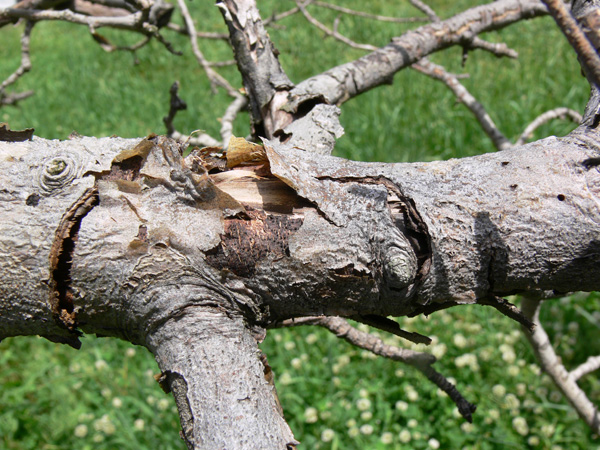Black rot cankers showing up in apples
Learn how to identify black rot cankers caused by the fungus Botryosphaeria obtuse in apple trees.
Some apple growers are noticing a higher incidence of cankers on branches and trunks of apple trees in their orchards this season. Many of these cankers are Black rot cankers caused by the fungus Botryosphaeria obtuse. The black rot fungus can infect limbs, trunks, leaves and fruit. The pathogen cannot infect healthy wood directly. Wounds on limbs and trunks caused by hail, winter injury, mechanical injury, insects or other diseases provide an entrance for the black rot fungus to infect and colonize. Depending upon when the injury occurred and how sever it was, growers may not recognize the subtle early symptoms of black rot cankers that develop on wounded limbs or trunks during the year of injury. Often the disease is mistakenly identified as winter injury. Winter injury of wood may be the primary cause of damage which creates the wound for the black rot pathogen to enter and cause further damage. Often it takes 2 years before obvious symptoms of black rot cankers to show up. Many of the larger cankers observed this season were probably a result of infection of winter injured wood last year during the 2014 winter. It is possible that more cankers will show up next year due to the winter injury from this past winter 2015.
Early symptoms of black rot cankers on limbs and trunks are subtle and first appear as reddish or dark purplish, brown sometimes slightly sunken areas under the bark (Figure 1). Although the slightly sunken areas often remain small and superficial, some can enlarge up to half a meter in length under the bark. Regardless, as the cankers age by the second year, the infected bark dies, cracks and peels away from the sunken area exposing black diseased wood underneath (Figure 2).


The severity of damage to the trees due to black rot cankers varies depending on the location of the canker in the tree. Cankers on limbs can cause the entire limb to die back or they can weaken limbs to the point of breaking under heavy fruit loads or during a wind storm. Infections on the main trunk particularly on young trees can eventually girdle the tree resulting in premature death. If the injury occurred mid-way up the main trunk, the top of the tree may decline or die while remaining limbs and trunk below the injury and black rot canker remains relatively healthy for a while.
The black rot fungus can overwinter in cankers on both live and dead trees and in mummified fruit left in apple trees from the previous year. Mummified fruit left in trees should be removed when ever found in a tree but particularly during dormant season pruning when they can be seen more easily. Pruning out diseased and cankered limbs and dead wood during the dormant season is an important practice to reduce the inoculum sources. Cankers may be surgically removed from trees if feasible and practical. It is important to remove the infected prunings or wood from the orchard since the black rot fungus can survive and produce spores on dead wood. Burning or chopping up the prunings on the orchard floor with a flail mower should reduce inoculum levels. It is not a good idea to stack wood in piles near orchards since it may be colonized by the Black rot fungus and act as a source of inoculum.
There are no apple cultivars that are completely resistant to black rot; however some cultivars are less susceptible to limb cankers than others. If a new orchard is being planted near a woodlot, special care should be made to plant least susceptible cultivars on tolerant root stocks closest to the woodlot to reduce the impact of disease moving from the woodlot into the orchard. Applying fungicides such as Captan or Maestro, Pristine or Allegro for summer disease management throughout the growing season starting at petal fall and particularly immediately after a traumatic event caused by hail or wind will help protect the wounds on limbs from being colonized by the black rot fungus and reduce cankers from developing. Always follow the label when applying a pesticide.